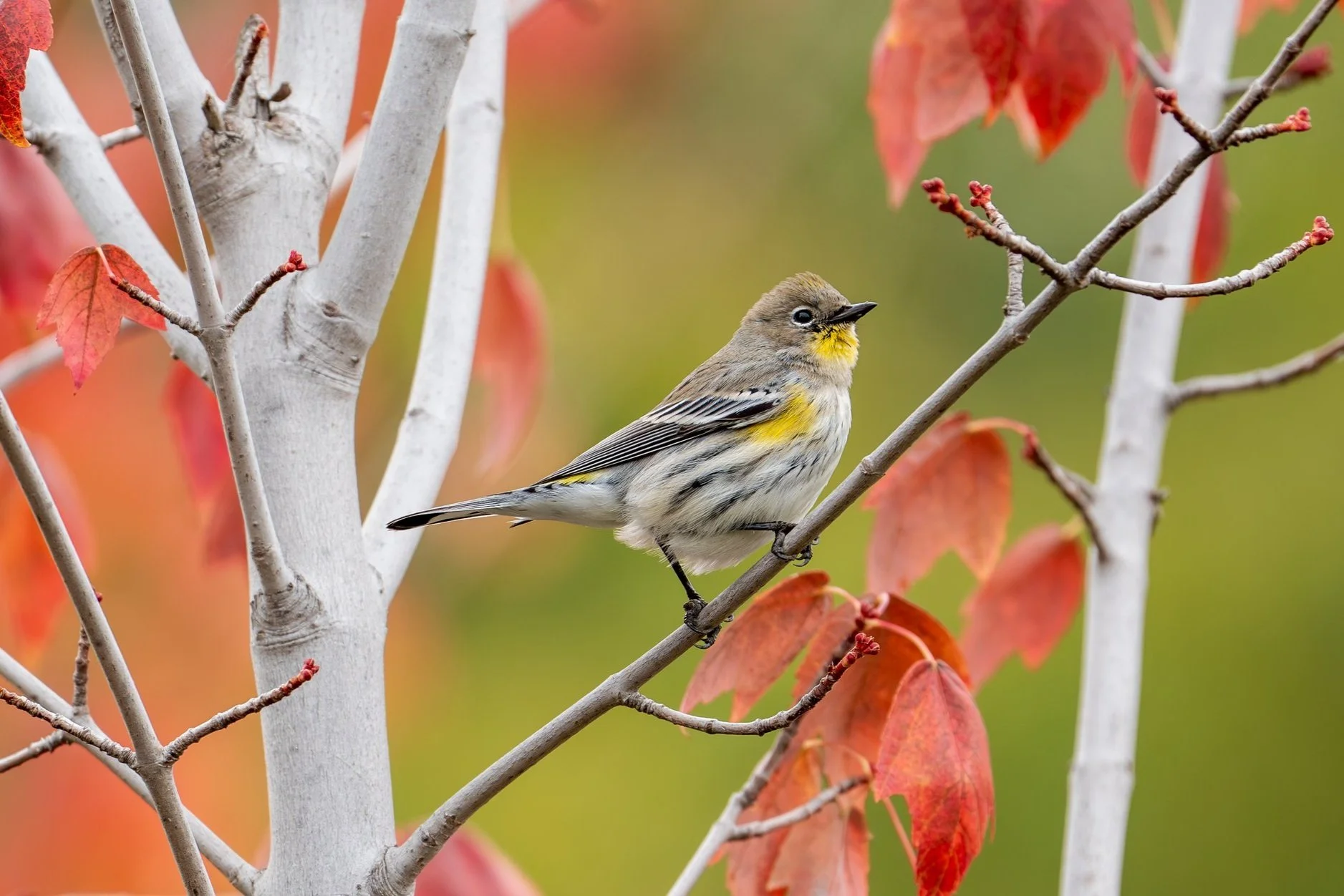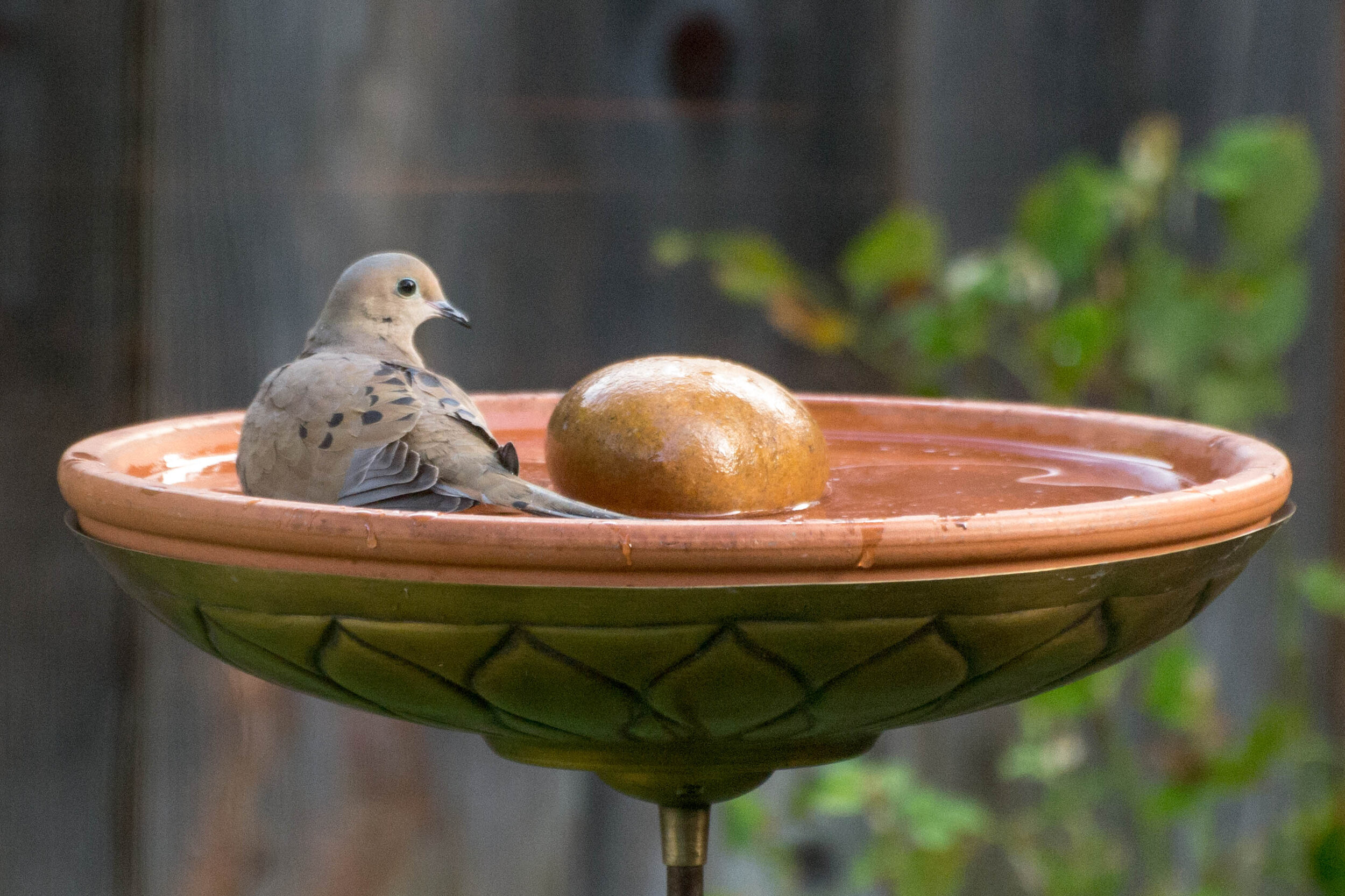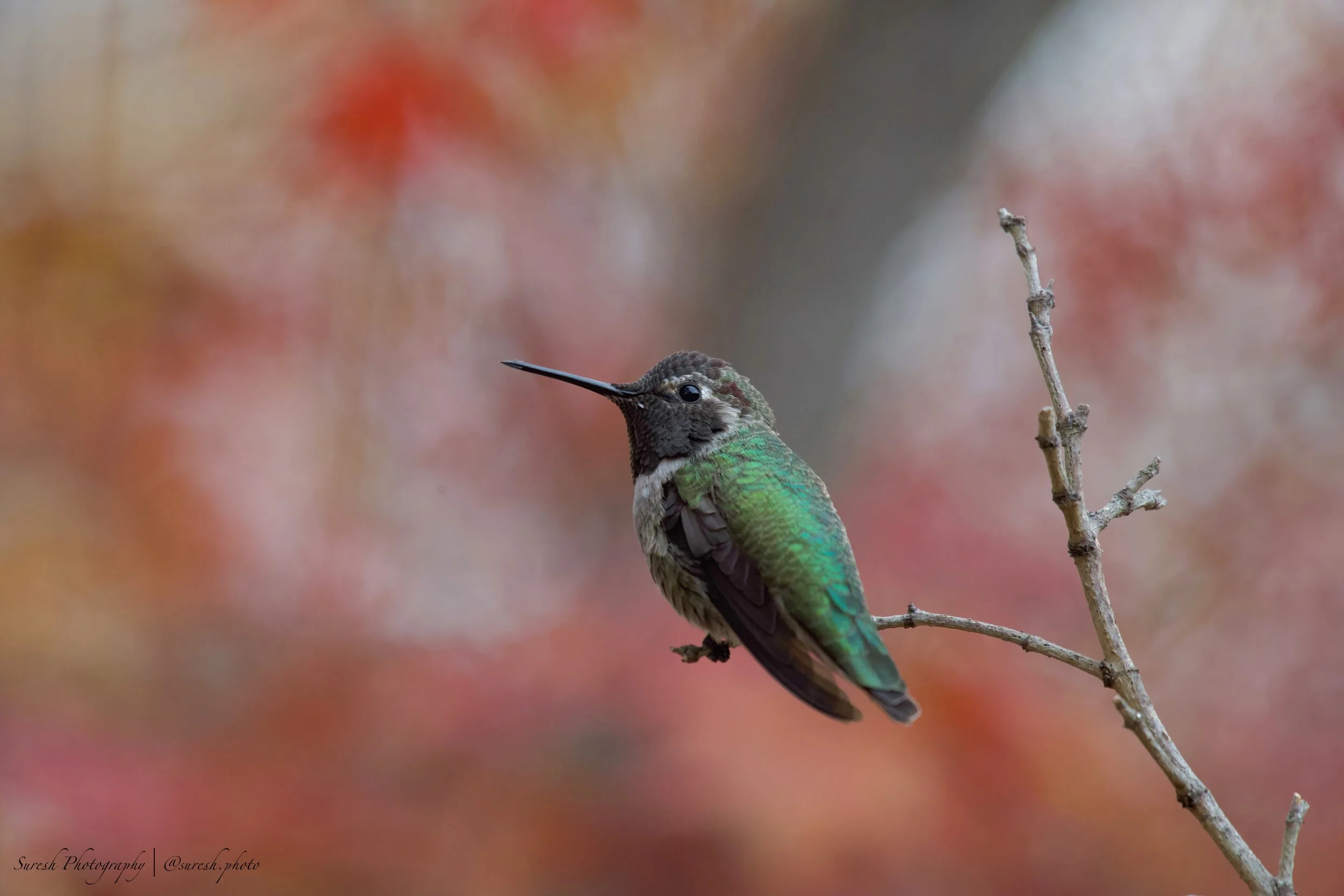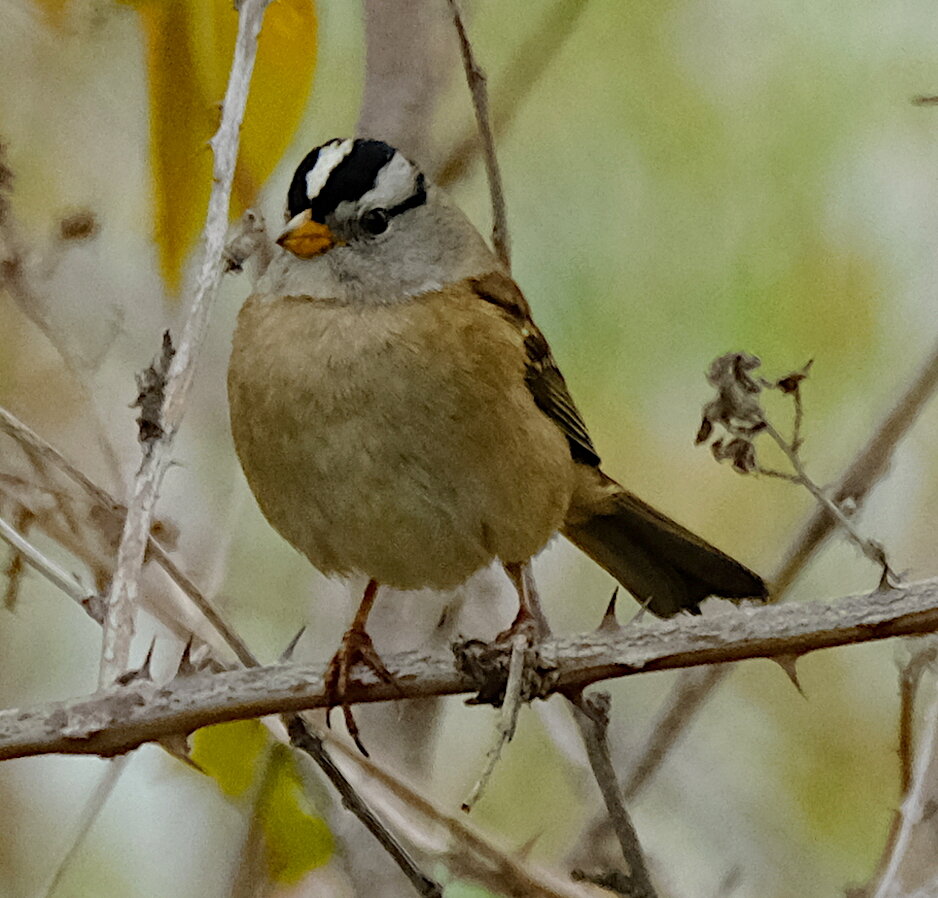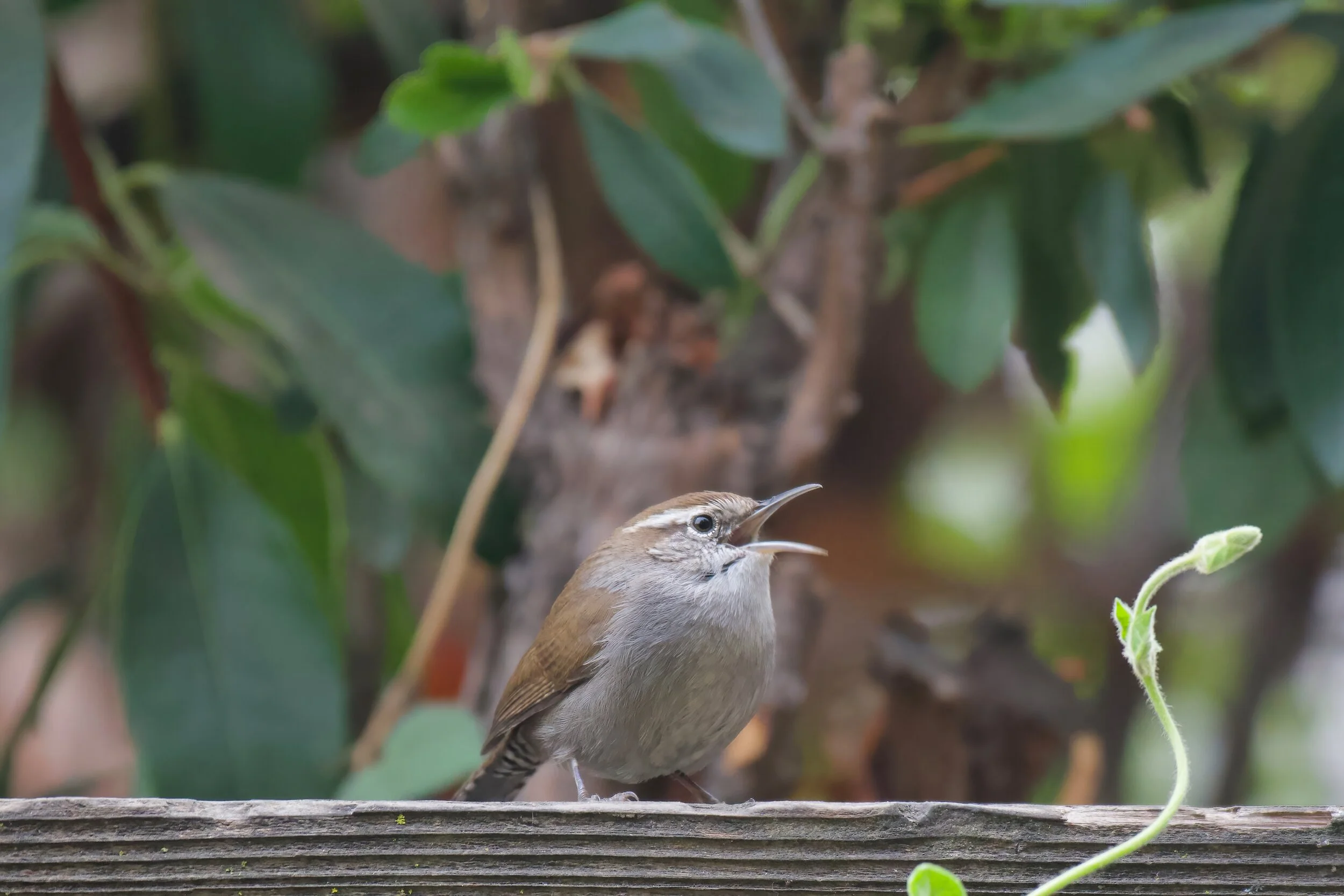Pine Siskins Galore...and More!
BY JULIE AMATO
Finally, it has rained. Brisk north winds, cloudy skies, and a damp chill ushered in the first good storm of the fall, and I woke one morning to a gleaming wet yard and the rhythmic tap of water dripping in the gutters. With the heat and smoke of recent months barely behind us, the change is welcome.
Winter is fast approaching, and as the temperatures drop more at night, and the humidity goes up, I am seeing more and more birds in my yard, availing themselves of the food on offer. There is an increasing number of species, including new winter arrivals, as well as a growing number of individuals, all of which is shaking up the pecking order and leading to some ruffled feathers.
Recent highlights in our yard
Pine Siskin in our yard
Pine Siskins are here! One bird snuck into the mix at our hopper feeder in early November, and it has been back with its cohorts nearly every day since. At first, this little finch can be hard to tell apart from a House Finch: look for heavy striping, with greater contrast between the stripes and the rest of the body than a House Finch has; a thin pointed bill (the House has a thick conical one); and a mesmerizing burst of lemon-yellow color when it opens its wings. When the bird is at rest, a thin yellow line can sometimes be seen along the edge of the wings, as in the picture above.
Siskin “tolerating” House Finches at our bird bath
This is an irruptive year for Pine Siskins, which means that large numbers of these migratory birds have descended from Canada to spend the winter here. In fact, the National Audubon Society says that this may be a record-making year for Siskins and that you can find them virtually everywhere in the U.S. If you haven’t seen them in your yard before, keep an eye out for them this winter!
Siskin shows a Lesser Goldfinch who’s boss
With the weather getting colder and wetter, there are more squabbles among the birds at my feeders. While working in my home office, I frequently witness explosions of wings, feathers, and angry chatter, as various members of the finch family jockey for who’s on first: House Finches, Lesser Goldfinches, American Goldfinches, and Pine Siskins all vie simultaneously for prime positions on the hopper feeder. The Houses usually win, although if the smaller Lessers show up in a group, they can sometimes dethrone the other birds. The Siskins are small but mighty, and will defend their positions by jabbing their heads in the direction of interlopers and telling them to back off!
Hermit Thrush in our yard, at a shy moment
Other birds have startled me with unexpected shows of aggression. One morning a Black Phoebe and a Hermit Thrush were foraging in the same corner of the yard. Suddenly the Phoebe flew directly at the Thrush, which quickly left the scene. That was that, I thought, but a minute or two later, the Thrush had returned, perching peaceably enough on the fence - until it abruptly dive-bombed the Phoebe and drove it away! I wouldn’t have thought that these two species would have it in for each other, but on this particular cold, wet day, perhaps some resource competition was going on. Or maybe these two birds just personally disliked each other?
Brown Creeper, doing what it does best - creeping!
In other news, I saw my first Brown Creeper in a while, when movement in a street tree caught my eye while I was at the kitchen sink. I raced out, hands dripping wet, and managed to get there on time to snap a few pictures as the bird hopped up and down and around the trunk, at gravity-defying angles, probing for insects (the camera got damp but survived).
American Goldfinch, with Lesser Goldfinches and a House Finch (don’t be fooled by the serenity of the moment!)
American Goldfinches have made their seasonal debut in our yard as well. If your mental image of an American Gold is of a brilliant yellow bird, you would be right - but only in the summer months. In the winter, look for a dramatically different bird, one that is mostly a muted beige, with some yellow on the face and neck, and bold white stripes on black wings. This is the American Goldfinch’s non-breeding plumage.
Of course, all of our regular visitors are also here. Flocks of Mourning Doves forage at dusk before flying to a nearby tree to roost for the night. California Scrub-Jays come to snatch peanuts. Bewick’s Wrens specialize in gleaning insects from the nooks and crannies of the structures in our yard - the fence, the eaves, and lately, the grooves and edges of the paved patio. White-crowned and Golden-crowned Sparrows fill the yard at dawn, dropping through the branches of the blue potato bush like rain. I suspect they cause some trepidation among our year-round resident sparrows, the Dark-eyed Junco and the California Towhee, who haven’t been as visible in the yard since the crowned sparrows arrived for the winter.
What to look for in December
In addition to our year-round residents and early winter arrivals, expect to see many of the birds I introduced for the month of November, including Ruby-crowned Kinglets and Yellow-rumped Warblers.
Woodpeckers are active throughout the winter. The Nuttall’s Woodpecker is our Backyard Bird of the Month right now. Almost exclusively found in California, it is common in suburban areas, where you will often find one drumming away on a utility pole.
Listen also for the squeaky kyeer and wicka-wicka calls of the Northern Flicker, which is also in the woodpecker family. Although Flickers will forage on the ground, I have usually found them in tall trees in my yard. They haven’t shown up at our place yet, but we did see two while walking around the neighborhood recently.
One December, we saw a Bald Eagle soaring high in the sky above our home. While these birds can be seen year-round in our county, I usually spot them in flight during the winter months. Step outside and look up!
Cedar Waxwings - delightful masked bandits, with red drops on their wings like sealing wax - should be seen more frequently and abundantly now. The December high count in my yard is 35 of them. These highly social birds can be a bit unpredictable at any location - as fruit eaters, they wander in search of ripe fruit and berries, and can show up unexpectedly. I am still waiting to see my first Waxwing this winter!
Male House Finch with a gleaming ruby forehead
If you have feeders, expect an uptick in House Finches as the weather gets colder - note how the males’ feathers are getting redder and redder. Look also for increasing numbers of Pine Siskins at your feeders and bird baths.
Mourning Dove hanging out in the bird bath
Scattering seed on the ground will attract abundant ground feeders like Mourning Doves and members of the sparrow family, especially White-crowned and Golden-crowned Sparrows. Chestnut-backed Chickadees, Oak Titmice, and White-breasted Nuthatches are fewer in number, but nevertheless faithful feeder visitors throughout the winter.
Getting into backyard birding
It’s fun to see how birds of different species relate to each other. Dominance hierarchies (who is bolder than whom, and who displaces whom at feeders) have been studied using data from Project FeederWatch. Usually the bigger birds win - but not always! Read this article to find out the competitive “ability scores” of common feeder birds, and see if they match your observations in your yard.
What birds are in your yard?
What are you seeing and hearing in your yard now? All observations are good, and species ID’s aren’t necessary! (In fact, we can help with that.)
Drop us a note or send a photo or sound clip to backyardbirds@scvas.org. We’ll share your submittals in our new feature, All Around Town.
More resources
This winter, count birds at home for science! Project FeederWatch, a citizen science project of the Cornell Lab of Ornithology, is now underway for the season. For information about how to participate, see the FeederWatch website.
For more information about backyard bird feeding, see our Backyard Birding page.
To learn more about backyard bird species, see our list of common backyard birds in Santa Clara County and read all about our backyard bird of the month.
Julie’s Backyard Bird List (October 21-November 22, 2020)
Mourning Dove
Anna’s Hummingbird
Turkey Vulture (flyover)
Cooper’s Hawk
Nuttall’s Woodpecker
Black Phoebe
California Scrub-Jay
American Crow
Chestnut-backed Chickadee
Oak Titmouse
Bushtit
Ruby-crowned Kinglet
White-breasted Nuthatch
Brown Creeper
Bewick’s Wren
Northern Mockingbird
Hermit Thrush
House Finch
Pine Siskin
Lesser Goldfinch
American Goldfinch
Dark-eyed Junco
White-crowned Sparrow
Golden-crowned Sparrow
Lincoln’s Sparrow
California Towhee
Spotted Towhee
Yellow-rumped Warbler
Banner photo by Brooke Miller.
All other photos by Julie Amato.

